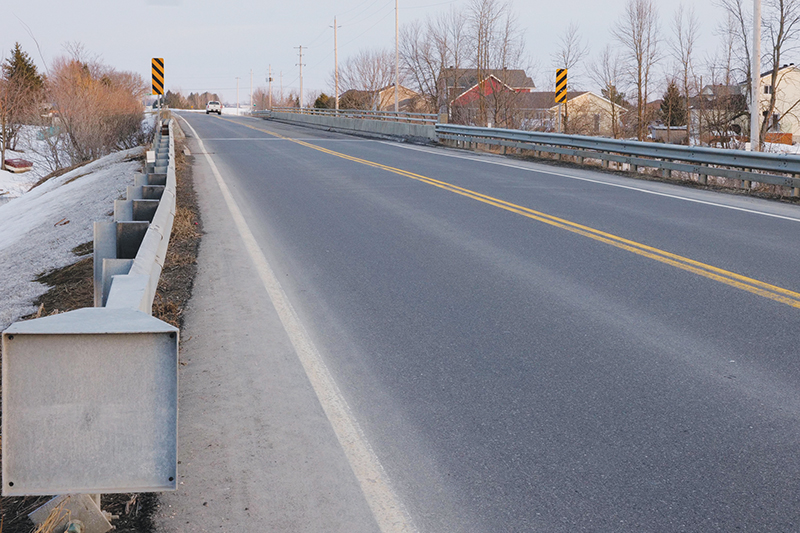Michael Jans, P. Eng., manager of infrastructure for the counties of SDG was on hand to field question from members of the public at an information session held at the Nelson Laprade Centre concerning the detour required by the rehabilitation of the South Nation bridge. Tinkess Photo
CHESTERVILLE – A major rehabilitation of the South Nation bridge on County Road 43, south of Chesterville later this year, will see all traffic detour through the village from May 1 until Oct. 13.
The bridge, built in 1971 will undergo pier repairs, deck strengthening, bridge jacking, bearing replacement, semi-integral joint replacement, barrier wall and curb replacement, various partial depth concrete repairs, waterproofing and paving work.
Information regarding the closure was provided during an information session held at the Nelson Laprade Centre, 9 William St. in Chesterville on Mon., March 20. Michael Jans, P. Eng., manager of infrastructure for the Counties of SDG was on hand to field questions from members of the public. According to Jans, the meeting went better than he had expected.
“I’m pleasantly surprised by the number of people that have shown up, said Jans. “I was hoping to get more than half a dozen. I’m happy with the number of people, very engaged people with a lot of questions. It’s been pretty good. I’m happy to have those conversations.”
The questions Jans faced ranged from how the detour would affect local events and activities, to what would be done to ensure pedestrian safety because of the increased traffic flow. Diagrams showing three different detour routes were provided, but attendees were also invited to make suggestions.
It was explained during the session that in terms of cost and time, it’s better to regularly maintain infrastructure items like the bridge, than to have to replace them.
“Every bridge that goes up, you generally have to go back about once every 30 years,” said Jans. “It’s just the salt is hard on them, the oxygen, the rain, everything, even the traffic, the vibrations slowly weaken the bridge, because concrete cracks naturally on its own, but then just the vibrations of vehicles propagate those cracks. The salt makes it to the steel, the steel rusts. Rusting steel expands and pushes the concrete off, and it just accelerates; therefore, the rule of thumb on bridges built in the 60s and 70s is every 30 years bridge rehab is required, with the way bridges have been built. In the last 20-30 years, we’re seeing a lot of ways to increase that interval.
“One of the things that we’re looking at now is concrete sealers. It prevents the salt from getting into the concrete to a significant degree, but you must apply it very regularly. We’re looking at what that looks like for us.”
Jans says they are aware of the concerns of residents over the increased traffic flow. He says the counties have several proposals to monitor the situation as it evolves. “We’re going to be putting signs up in advance and warning people with the detours,” says Jans, “And we’re hoping that as many people as possible find, maybe it’s easy for them to pick a wider route and go around through a different area. It is a relatively short detour. That may not happen to the degree that we’d like, but we are keeping an eye on options, to not necessarily constrict the flow and bog everyone down but just keep everything moving but at a proper pace.
“We’re proposing radar signs so that we can track how fast people are moving,” added Jans. “We can turn around and share that with the OPP and ask them to get out there and keep the pedestrians safe. There are other options for traffic controls, new traffic controls on a temporary basis that aren’t there right now. We’re going to keep an eye on the entire situation. Keep an eye on the traffic, keep an eye on what people are experiencing, kind of work out solutions on the fly to try and keep everybody moving along and safe and peaceful.”
There were questionnaires for attendees to fill out, but anyone with an interest is welcome to share their viewpoint. “I’ve got until about April 14 to compile comments from the public,” said Jans, “From residents, from commuters, from anybody who’s got a stake in this. The sooner, the better: I’ve got to attend the North Dundas Council meeting and relay what our communications and findings have been up until that point. They’re going to decide on what they think is best for the village. I’m sure that they’re going to have a message for county council, which meets on April 17, I believe. That’s when ultimately the decision will be made. We’ll have the reaction from the public, we’ll have the message from the local council, and we’ll have the bids from the contractors at that point as well. And we’re going to lay it all out and there’ll be hopefully a good conversation on this and direction from council on which way we’re going to go.”
For more information on the South Nation Bridge rehabilitation, you can visit the following link: https://www.sdgcounties.ca/southnationbridgerehab.

Terry Tinkess is a professional photographer, educator and journalist. He has been making a living with a camera and keyboard since 1999 and has been featured in such publications as The Ottawa Citizen, Cornwall Standard Freeholder, The Globe and Mail, The Miami Herald, Ottawa Construction News, The Ontario Construction Report, Ontario Home Builder Magazine, Reed Construction Data, Canadian Potato Business and most recently, The Record and Eastern Ontario AgriNews. Terry lives in Ingleside, Ontario with his wife Brenda, Mia the anxious Pittie and cats Wally and Chubbers.









